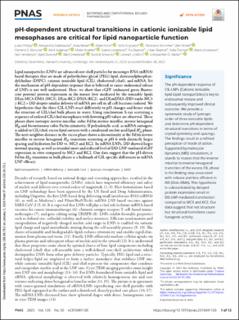pH-dependent structural transitions in cationic ionizable lipid mesophases are critical for lipid nanoparticle function
| dc.contributor.author | Philipp, Julian | |
| dc.contributor.author | Dabkowska, Aleksandra | |
| dc.contributor.author | Reiser, Anita | |
| dc.contributor.author | Frank, Kilian | |
| dc.contributor.author | Krzysztoń, Rafał | |
| dc.contributor.author | Brummer, Christiane | |
| dc.contributor.author | Nickel, Bert | |
| dc.contributor.author | Blanchet, Clement E. | |
| dc.contributor.author | Sudarsan, Akhil | |
| dc.contributor.author | Ibrahim, Mohd | |
| dc.contributor.author | Johansson, Svante | |
| dc.contributor.author | Skantze, Pia | |
| dc.contributor.author | Skantze, Urban | |
| dc.contributor.author | Östman, Sofia | |
| dc.contributor.author | Johansson, Marie | |
| dc.contributor.author | Henderson, Neil | |
| dc.contributor.author | Elvevold, Kjetil | |
| dc.contributor.author | Smedsrød, Bård | |
| dc.contributor.author | Schwierz, Nadine | |
| dc.contributor.author | Lindfors, Lennart | |
| dc.contributor.author | Rädler, Joachim O. | |
| dc.date.accessioned | 2024-01-04T09:10:39Z | |
| dc.date.available | 2024-01-04T09:10:39Z | |
| dc.date.created | 2023-12-20T12:29:12Z | |
| dc.date.issued | 2023 | |
| dc.identifier.citation | Proceedings of the National Academy of Sciences of the United States of America. 2023, 120 (50), . | |
| dc.identifier.issn | 0027-8424 | |
| dc.identifier.uri | https://hdl.handle.net/11250/3109752 | |
| dc.description.abstract | Lipid nanoparticles (LNPs) are advanced core-shell particles for messenger RNA (mRNA) based therapies that are made of polyethylene glycol (PEG) lipid, distearoylphosphatidylcholine (DSPC), cationic ionizable lipid (CIL), cholesterol (chol), and mRNA. Yet the mechanism of pH-dependent response that is believed to cause endosomal release of LNPs is not well understood. Here, we show that eGFP (enhanced green fluorescent protein) protein expression in the mouse liver mediated by the ionizable lipids DLin-MC3-DMA (MC3), DLin-KC2-DMA (KC2), and DLinDMA (DD) ranks MC3 ≥ KC2 > DD despite similar delivery of mRNA per cell in all cell fractions isolated. We hypothesize that the three CIL-LNPs react differently to pH changes and hence study the structure of CIL/chol bulk phases in water. Using synchrotron X-ray scattering a sequence of ordered CIL/chol mesophases with lowering pH values are observed. These phases show isotropic inverse micellar, cubic Fd3m inverse micellar, inverse hexagonal and bicontinuous cubic Pn3m symmetry. If polyadenylic acid, as mRNA surrogate, is added to CIL/chol, excess lipid coexists with a condensed nucleic acid lipid phase. The next-neighbor distance in the excess phase shows a discontinuity at the Fd3m inverse micellar to inverse hexagonal transition occurring at pH 6 with distinctly larger spacing and hydration for DD vs. MC3 and KC2. In mRNA LNPs, DD showed larger internal spacing, as well as retarded onset and reduced level of DD-LNP-mediated eGFP expression in vitro compared to MC3 and KC2. Our data suggest that the pH-driven Fd3m- transition in bulk phases is a hallmark of CIL-specific differences in mRNA LNP efficacy. | |
| dc.language.iso | eng | |
| dc.title | pH-dependent structural transitions in cationic ionizable lipid mesophases are critical for lipid nanoparticle function | |
| dc.title.alternative | pH-dependent structural transitions in cationic ionizable lipid mesophases are critical for lipid nanoparticle function | |
| dc.type | Peer reviewed | |
| dc.type | Journal article | |
| dc.description.version | publishedVersion | |
| dc.source.pagenumber | 0 | |
| dc.source.volume | 120 | |
| dc.source.journal | Proceedings of the National Academy of Sciences of the United States of America | |
| dc.source.issue | 50 | |
| dc.identifier.doi | 10.1073/pnas.2310491120 | |
| dc.identifier.cristin | 2216303 | |
| cristin.ispublished | true | |
| cristin.fulltext | original | |
| cristin.qualitycode | 2 |
Tilhørende fil(er)
Denne innførselen finnes i følgende samling(er)
-
Artikler / Articles [1449]
-
Publikasjoner fra CRIStin [2518]
